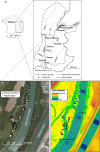Floodplain ecohydrology: Climatic, anthropogenic, and local physical controls on partitioning of water sources to riparian trees
- PMID: 25506099
- PMCID: PMC4258096
- DOI: 10.1002/2014WR015581
Floodplain ecohydrology: Climatic, anthropogenic, and local physical controls on partitioning of water sources to riparian trees
Abstract
Seasonal and annual partitioning of water within river floodplains has important implications for ecohydrologic links between the water cycle and tree growth. Climatic and hydrologic shifts alter water distribution between floodplain storage reservoirs (e.g., vadose, phreatic), affecting water availability to tree roots. Water partitioning is also dependent on the physical conditions that control tree rooting depth (e.g., gravel layers that impede root growth), the sources of contributing water, the rate of water drainage, and water residence times within particular storage reservoirs. We employ instrumental climate records alongside oxygen isotopes within tree rings and regional source waters, as well as topographic data and soil depth measurements, to infer the water sources used over several decades by two co-occurring tree species within a riparian floodplain along the Rhône River in France. We find that water partitioning to riparian trees is influenced by annual (wet versus dry years) and seasonal (spring snowmelt versus spring rainfall) fluctuations in climate. This influence depends strongly on local (tree level) conditions including floodplain surface elevation and subsurface gravel layer elevation. The latter represents the upper limit of the phreatic zone and therefore controls access to shallow groundwater. The difference between them, the thickness of the vadose zone, controls total soil moisture retention capacity. These factors thus modulate the climatic influence on tree ring isotopes. Additionally, we identified growth signatures and tree ring isotope changes associated with recent restoration of minimum streamflows in the Rhône, which made new phreatic water sources available to some trees in otherwise dry years.
Key points: Water shifts due to climatic fluctuations between floodplain storage reservoirsAnthropogenic changes to hydrology directly impact water available to treesEcohydrologic approaches to integration of hydrology afford new possibilities.
Keywords: Rhône; climate change; oxygen isotopes (δ18O); soil moisture; tree rings; water partitioning.
Figures












Similar articles
-
Putah Creek hydrology affecting riparian cottonwood and willow tree survival.Environ Monit Assess. 2018 Jul 11;190(8):458. doi: 10.1007/s10661-018-6841-x. Environ Monit Assess. 2018. PMID: 29995189
-
Contrasting controls on tree ring isotope variation for Amazon floodplain and terra firme trees.Tree Physiol. 2019 May 1;39(5):845-860. doi: 10.1093/treephys/tpz009. Tree Physiol. 2019. PMID: 30824929 Free PMC article.
-
Differential use of winter precipitation by upper and lower elevation Douglas fir in the Northern Rockies.Glob Chang Biol. 2018 Dec;24(12):5607-5621. doi: 10.1111/gcb.14435. Epub 2018 Oct 7. Glob Chang Biol. 2018. PMID: 30192433
-
Water source partitioning among trees growing on shallow karst soils in a seasonally dry tropical climate.Oecologia. 2007 May;152(1):26-36. doi: 10.1007/s00442-006-0629-3. Epub 2007 Jan 10. Oecologia. 2007. PMID: 17216213
-
Hydrologic regulation of plant rooting depth.Proc Natl Acad Sci U S A. 2017 Oct 3;114(40):10572-10577. doi: 10.1073/pnas.1712381114. Epub 2017 Sep 18. Proc Natl Acad Sci U S A. 2017. PMID: 28923923 Free PMC article. Review.
Cited by
-
Local groundwater decline exacerbates response of dryland riparian woodlands to climatic drought.Glob Chang Biol. 2022 Nov;28(22):6771-6788. doi: 10.1111/gcb.16376. Epub 2022 Aug 31. Glob Chang Biol. 2022. PMID: 36045489 Free PMC article.
-
Hourly potential evapotranspiration at 0.1° resolution for the global land surface from 1981-present.Sci Data. 2021 Aug 24;8(1):224. doi: 10.1038/s41597-021-01003-9. Sci Data. 2021. PMID: 34429438 Free PMC article.
-
Floodplain restoration increases hyporheic flow in the Yakima River Watershed, Washington.Ecol Eng. 2018;116:110-120. doi: 10.1016/j.ecoleng.2018.02.001. Ecol Eng. 2018. PMID: 31908361 Free PMC article.
-
Groundwater dependence of riparian woodlands and the disrupting effect of anthropogenically altered streamflow.Proc Natl Acad Sci U S A. 2021 Jun 22;118(25):e2026453118. doi: 10.1073/pnas.2026453118. Proc Natl Acad Sci U S A. 2021. PMID: 34161277 Free PMC article.
-
Ash dieback and hydrology affect tree growth patterns under climate change in European floodplain forests.Sci Rep. 2025 Mar 24;15(1):10117. doi: 10.1038/s41598-025-92079-5. Sci Rep. 2025. PMID: 40128345 Free PMC article.
References
-
- Adams MA. Grierson PF. Stable isotopes at natural abundance in terrestrial plant ecology and ecophysiology: An update. Plant Biol. 2001;3(4):299–310.
-
- Alstad KP, Welker JM, Williams SA. Trlica MJ. Carbon and water relations of Salix monticola in response to winter browsing and changes in surface water hydrology: An isotopic study using δ13C and δ18O. Oecologia. 1999;120(3):375–385. - PubMed
-
- Alstad KP, Hart SC, Horton JL. Kolb TE. Application of tree-ring isotopic analyses to reconstruct historical water use of riparian trees. Ecol. Appl. 2008;18(2):421–437. - PubMed
-
- Amlin NM. Rood SB. Drought stress and recovery of riparian cottonwoods due to water table alteration along Willow Creek, Alberta. Trees Struct. Funct. 2003;17(4):351–358.
-
- Amoros C, Elger A, Dufour S, Grosprêtre L, Piégay H. Henry C. Flood scouring and groundwater supply in side-channel rehabilitation of the Rhône river, France. Arch. Hydrobiol. 2005;155:147–167.
LinkOut - more resources
Full Text Sources
Other Literature Sources
